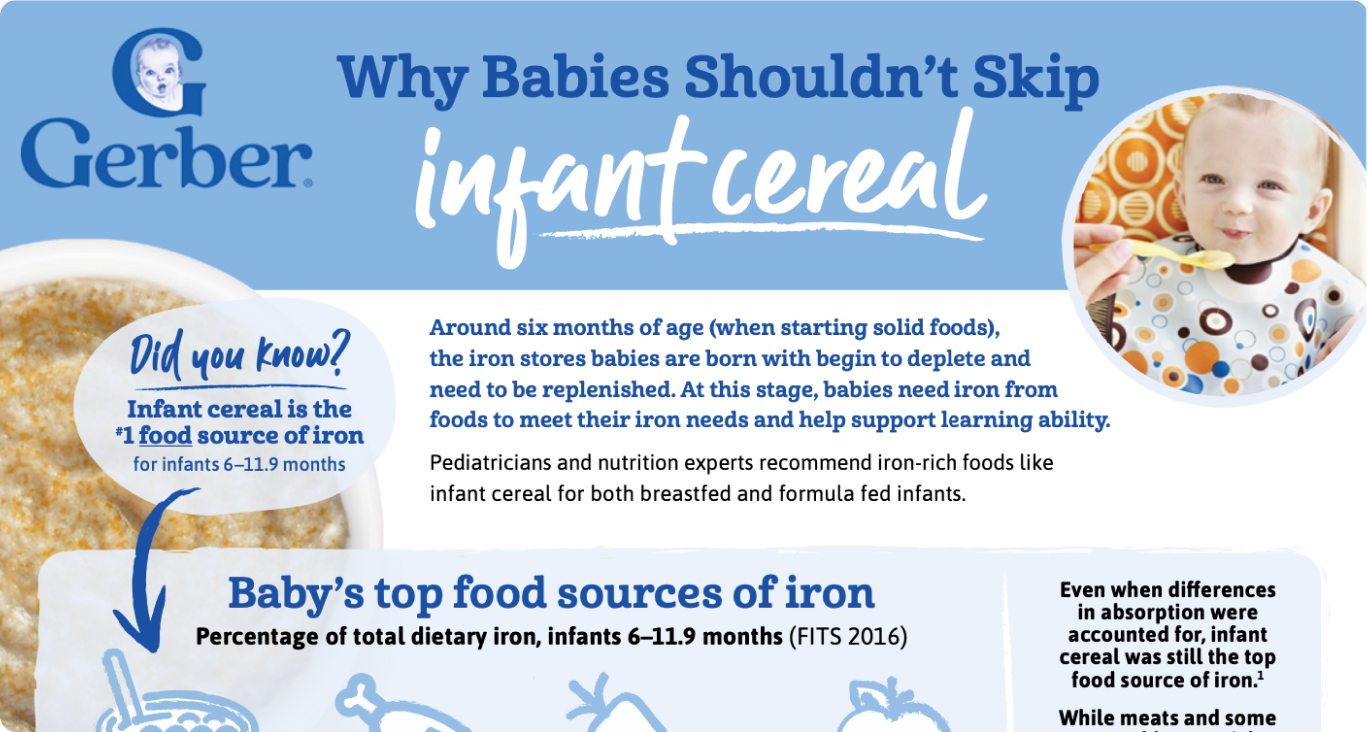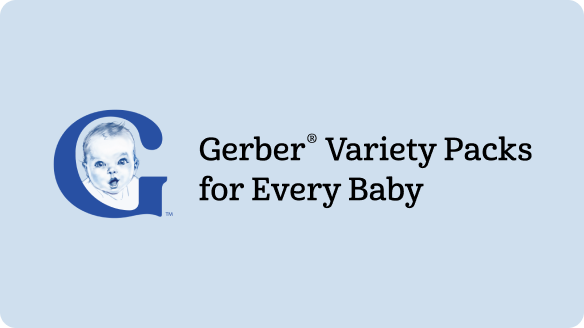Why Babies Shouldn't Skip Infant Cereal
3 min read • By: Gerber Medical Hub

Quick summary
Around six months, babies need iron-rich foods like infant cereal to support cognitive development as their natural iron stores decline. Pediatricians and nutrition experts recommend iron-rich foods like infant cereal, a top source of dietary iron, crucial for breastfed and mixed-fed infants.
picture_as_pdfVIEW PDF INFOGRAPHIC
Table of contents
Start iron-rich foods around six months
Around six months of age (when starting solid foods), the iron stores babies are born with begin to deplete and need to be replenished. At this stage, babies need iron from foods to meet their iron needs and help support learning ability.
Pediatricians and nutrition experts recommend iron-rich foods like infant cereal for both breastfed and formula fed infants.
Baby's top food sources of iron
Percentage of total dietary iron, infants 6-11.9 months (FITS 2016)
- 34% Infant Cereal
- 4% Mixed Dishes & Meats/Protein
- 3% Vegetables
- 3% Fruits
Even when differences in absorption were accounted for, infant cereal was still the top food source of iron.1
While meats and some vegetables are rich in iron, babies usually eat small amounts.
Infant cereal makes an impact because it is:
- High in iron
- Eaten often
Did you know?
Infant cereal is the #1 food source of iron for infants 6-11.9 months
Daily iron intake
Research shows without infant cereal, 96% of breastfed babies don't get enough iron.2 Even when baby is supplemented with infant formula, 70% of mixed fed infants have inadequate iron intakes without infant cereal.2
Percentage of Breastfeed Infants with Inadequate Iron Intake

Percentage of Mixed Fed Infants with Inadequate Iron Intake

Total daily iron intake from infant cereal
Infant cereal provides 7% of the total daily iron intake among breastfed infants who consume infant cereal.† Just 2 servings per day meets baby's daily iron needs plus zinc, calcium, vitamin C, vitamin E, and six B vitamins for healthy development.
Gerber® Powerblend™ cereals to nourish brain and body
Diet diversity is an important pillar of human health right from the baby years. The Dietary Guidelines for Americans highlight the importance of nutrient dense foods like whole grains, legumes and vegetables for babies.
Powerblend™ cereals are the first infant cereal made with a unique blend of whole grain oats, lentils, veggies, fruit and nutrients working together to support baby's brain and body.

Support healthy growth
Just two servings of Gerber® infant cereal meet baby's daily iron need to support healthy growth and brain development.
Nourish little tummies
Getting enough vitamins B, C, E, zinc & probiotics daily helps support baby's developing immune system. Every serving has probiotic B. lactis to support digestive health and a balanced microbiome when eaten on a regular basis.
Promote a diversified diet
Encourage baby's love of nutritious foods. Powerblend™ cereals have 1/3 serving of veggies and 10g whole grains!
 LEARN MORE ABOUT INFANT CEREAL
LEARN MORE ABOUT INFANT CEREAL Footnotes and references
† Among 6-11.9 month old infants receiving breastmilk and infant cereal, but no infant formula. Includes nutrients from supplements. (FITS 2016 — data on file).
* Among pediatricians who recommend infant cereal.
Abrams SA, Hampton JC, Finn KL. A substantial proportion of 6- to 12-month-old infants have calculated daily absorbed iron below recommendations, especially those who are breastfed. J Pediatr. 2021;231:36-42 e2. 2. Finn K, Kineman B, Carvalho R. Concerning impact of decreasing infant cereal consumption on essential nutrient intakes of breastfed babies: feeding infants and toddlers study (FITS) 2016. Current Developments in Nutrition. 2019; 3(S1):P11-064-19. [ABSTRACT].



